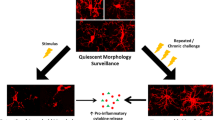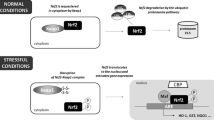Abstract
Although heat stress induces a variety of illnesses, there have been few studies designed to uncover the molecular mechanisms underlining the illnesses. We here demonstrate that heat activates ER stress, which inhibits heat shock responses (HSR) via translational block. In heat-stressed rats, ER stress responses, as represented by eIF2α phosphorylation and XBP1 splicing, occurred mainly in the cortex, where the HSR was substantially inhibited. Heat exposure also activated ER stress signals in primary cortical neurons. Since HSF1 knockdown enhanced heat-induced ER stress and subsequent cell death, HSR inhibition in turn augments ER stress, implying a vicious spiral of both stresses. Taken together, heat-induced ER stress impairs the HSR and enhances cell damage, thereby manifesting its unique effect on heat stress.




Similar content being viewed by others
Abbreviations
- XBP1:
-
X-box binding protein
- MEF:
-
Mouse embryonic fibroblast
- ER:
-
Endoplasmic reticulum
- HSF1:
-
Heat shock transcription factor
- eIF2:
-
Eukaryote initiation factor 2
References
Morimoto RI (2008) Proteotoxic stress and inducible chaperone networks in neurodegenerative disease and aging. Genes Dev 22:1427–1438
McMillan DR, Xiao X, Shao L, Graves K, Benjamin IJ (1998) Targeted disruption of heat shock transcription factor 1 abolishes thermotolerance and protection against heat-inducible apoptosis. J Biol Chem 273:7523–7528
Luft JC, Benjamin IJ, Mestril R, Dix DJ (2001) Heat shock factor 1-mediated thermotolerance prevents cell death and results in G2/M cell cycle arrest. Cell Stress Chaperones 6:326–336
Zhang Y, Huang L, Zhang J, Moskophidis D, Mivechi NF (2002) Targeted disruption of hsf1 leads to lack of thermotolerance and defines tissue-specific regulation for stress-inducible Hsp molecular chaperones. J Cell Biochem 86:376–393
Kostova Z, Wolf DH (2003) For whom the bell tolls: protein quality control of the endoplasmic reticulum and the ubiquitin-proteasome connection. EMBO J 22:2309–2317
Meusser B, Hirsch C, Jarosch E, Sommer T (2005) ERAD: the long road to destruction. Nat Cell Biol 7:766–772
Ron D, Walter P (2007) Signal integration in the endoplasmic reticulum unfolded protein response. Nat Rev Mol Cell Biol 8:519–529
Doerrler WT, Lehrman MA (1999) Regulation of the dolichol pathway in human fibroblasts by the endoplasmic reticulum unfolded protein response. Proc Natl Acad Sci USA 96:13050–13055
Li WW, Alexandre S, Cao X, Lee AS (1993) Transactivation of the grp78 promoter by Ca2+ depletion. A comparative analysis with A23187 and the endoplasmic reticulum Ca(2+)-ATPase inhibitor thapsigargin. J Biol Chem 268:12003–12009
Wooden SK, Li LJ, Navarro D, Qadri I, Pereira L, Lee AS (1991) Transactivation of the grp78 promoter by malfolded proteins, glycosylation block, and calcium ionophore is mediated through a proximal region containing a CCAAT motif which interacts with CTF/NF-I. Mol Cell Biol 11:5612–5623
Adachi M, Liu Y, Fujii K, Calderwood SK, Nakai A, Imai K, Shinomura Y (2009) Oxidative stress impairs the heat stress response and delays unfolded protein recovery. PLoS One 4:e7719 (1–10)
Dietrich WD, Busto R, Valdes I, Loor Y (1990) Effects of normothermic versus mild hyperthermic forebrain ischemia in rats. Stroke 21:1318–1325
Sinigaglia-Coimbra R, Cavalheiro EA, Coimbra CG (2002) Postischemic hyperthermia induces Alzheimer-like pathology in the rat brain. Acta Neuropathol 103:444–452
Arumugam TV, Phillips TM, Cheng A, Morrell CH, Mattson MP, Wan R (2010) Age and energy intake interact to modify cell stress pathways and stroke outcome. Ann Neurol 67:41–52
Tateno M, Ukai W, Hashimoto E, Ikeda H, Saito T (2006) Implication of increased NRSF/REST binding activity in the mechanism of ethanol inhibition of neuronal differentiation. J Neural Transm 113:283–293
Yoshida H, Matsui T, Yamamoto A, Okada T, Mori K (2001) XBP1 mRNA is induced by ATF6 and spliced by IRE1 in response to ER stress to produce a highly active transcription factor. Cell 107:881–891
Mohr I, Gluzman Y (1996) A herpesvirus genetic element which affects translation in the absence of the viral GADD34 function. EMBO J 15:4759–4766
Oyadomari S, Mori M (2004) Roles of CHOP/GADD153 in endoplasmic reticulum stress. Cell Death Differ 11:381–389
Kozutsumi Y, Segal M, Normington K, Gething MJ, Sambrook J (1988) The presence of malfolded proteins in the endoplasmic reticulum signals the induction of glucose-regulated proteins. Nature 332:462–464
Morris JA, Dorner AJ, Edwards CA, Hendershot LM, Kaufman RJ (1997) Immunoglobulin binding protein (BiP) function is required to protect cells from endoplasmic reticulum stress but is not required for the secretion of selective proteins. J Biol Chem 272:4327–4334
Bouchama A, Knochel JP (2002) Heat stroke. N Engl J Med 346:1978–1988
Han AP, Yu C, Lu L, Fujiwara Y, Browne C, Chin G, Fleming M, Leboulch P, Orkin SH, Chen JJ (2001) Heme-regulated eIF2alpha kinase (HRI) is required for translational regulation and survival of erythroid precursors in iron deficiency. EMBO J 20:6909–6918
Harding HP, Zhang Y, Bertolotti A, Zeng H, Ron D (2000) Perk is essential for translational regulation and cell survival during the unfolded protein response. Mol Cell 5:897–904
Acknowledgments
Supported in part by grants from the Ministry of Education, Culture, Sports, Science, Japan (to M.A, M.H., K.I., Y.S.). We are grateful to Dr. Peter M Olley (Sapporo Medical University School of Medicine) for editorial help.
Author information
Authors and Affiliations
Corresponding author
Additional information
Yaohua Liu and Hiroaki Sakamoto contributed equally to this work.
Rights and permissions
About this article
Cite this article
Liu, Y., Sakamoto, H., Adachi, M. et al. Heat stress activates ER stress signals which suppress the heat shock response, an effect occurring preferentially in the cortex in rats. Mol Biol Rep 39, 3987–3993 (2012). https://doi.org/10.1007/s11033-011-1179-2
Received:
Accepted:
Published:
Issue Date:
DOI: https://doi.org/10.1007/s11033-011-1179-2




